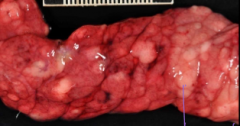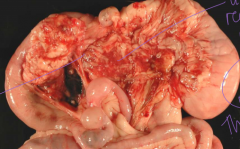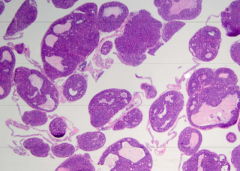![]()
![]()
![]()
Use LEFT and RIGHT arrow keys to navigate between flashcards;
Use UP and DOWN arrow keys to flip the card;
H to show hint;
A reads text to speech;
23 Cards in this Set
- Front
- Back
|
pancreatitis and pancreatic necrosis are more likely to occur in: a) middle aged, male, obese dogs b) middle aged, female, obese dogs c) middle aged, male, obese cats d) middle aged, female, obese cats |
b) middle aged, female, obese dogs
|
|
|
what are the 2 active digestive enzymes contained in a zymogen? a) trypsinogen b) lipase c) secretin d) amylase |
lipase and amylase |
|
|
which of the following is NOT a systemic effect of pancreatic necrosis: a) inflammation b) DIC c) Shock d) cardiopulmonary dysfunction e) peritonitis
|
They're all systemic effects!
|
|
|
what is the most common etiology of pancreatic necrosis? a) idiopathic b) nutrition c) drug d) ischemia e) obstruction |
a) idiopathic |
|
|
what is the best treatment for pancreatitis? a) supportive care b) NSAIDs c) low protein diet d) high protein diet |
a) supportive care |
|
|
T/F: pancreatic necrosis is often sterile and rarely infectious |
True |
|
|
what are NOT histologic features of acute pancreatic necrosis? a) edema b) lymphocytes c) sapponified fat d) neutrophils e) fibrosis f) hemorrhage |
b) and e) lymphocytes and fibrosis
|
|
|
what disease process is a sequelae of only acute, but not chronic pancreatitis? a) necrotizing pancreatitis b) fibrinous peritonitis c) fibrinous pancreatitis d) necrotizing peritonitis |
b) fibrinous peritonitis |
|
|
what are NOT histologic features of chronic pancreatitis? a) missing ducts and islets b) missing acinar cells c) lymphocytes d) plasma cells |
a) missing ducts and islets these are the components that are still present, acinar is missing |
|
|
what is the test of choice for diagnosing pancreatic necrosis?
a) chemistry/CBC b) TLI c) spec cPL d) imaging e) laparotomy/laproscopy/biopsy |
c) spec cPL |
|
|
what CS are NOT associated with pancreatic necrosis? a) painful abdomen b) anorexia c) regurg/vomiting d) melena/hematochezia e) fever f) non of the above |
none of the above
they're all associated CS |
|
|
how can pancreatic necrosis manifest in a cat (& ruminants)? a) triaditis b) colic c) nodular hyperplasia d) all of the above
|
a) triaditis
b/c they lack minor duodenal papilla
|
|
|
what inflammatory processes does feline triaditis commonly involve? a) gastritis b) duodenitis c) cholangitis d) cholecystitis e) pancreatitis |
duodenitis, cholangitis, pancreatitis |
|
|
zinc toxicosis mainly happens in a) dogs b) cats c) birds d) sheep e) horses |
c and d birds and sheep |
|
|
what organs does zinc toxicosis NOT target?
a) pancreas b) SI c) RBC d) kidney e) liver |
b) SI |
|
|
what chronic CS does zinc toxicosis present? a) fibrosis b) fat sapponification c) atrophy d) a & c e) a & b |
a & c fibrosis and atrophy |
|
|
which is the most common cause of exocrine pancreatic insufficiency? a) canine pancreatic atrophy b) chronic, recurrent pancreatitis c) neoplasia d) duct obstruction |
a) canine pancreatic atrophy |
|
|
what is the treatment of choice for EPI? |
pancreazymes |
|
|
what are the major CS of EPI? a) voluminous steatorrhea b) massive weight loss c) weight gain d) ravenous appetite e) anorexia |
a) voluminous steatorrhea b) massive weight loss d) ravenous appetite |
|
|
what are the best forms of diagnosis for EPI? a) imaging b) laparotomy/biopsy c) CS d) TLI |
c and d CS and TLI TLI is low (which is opposite acute pancreatitis) |
|

what is this gross pathology most consistent with? is it normal, malignant, or benign? what species is this seen in? |
nodular hyperplasia it's not a tumor, seen especially in older cats, but we don't know why, |
|

what disease process is this gross pathology most consistent with? what lesion is sequela to this disease? what CS are sequela this disease in CATS only? |
pancreatic carcinoma acute necrotizing pancreatitis alopecia and shiny skin |
|

this is a histological slide of the omentum in a cat with pancreatic carcinoma. How do we know this metastasized from the pancreas? what is this form of metasis called? |
the pink granules are indicative of zymogens thus we know it metastasized to omentum carcinomatosis: carcinoma breaks through serosa and invades abdominal cavity |

